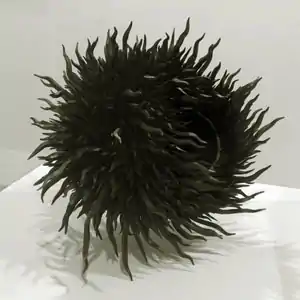Junko Mori
Junko Mori (森 純子, Mori Junko) (born 1974) is a Japanese artist and metalworker born in Yokohama, Japan. As a trained Blacksmith, Mori uses traditional techniques including the use of a hammer and anvil to create abstract sculptures designed to evoke a response from the viewer.[1]

Career
When discussing the establishment of her interest in art, Mori reflects on her fascination with microbiology during her childhood as a gateway to her creative vision.[1] Her interest in the subject of microbiology stemmed from being taught how to use a microscope by a teacher at school.[1] Mori studied at Musashino Art University in Tokyo where she worked from briefs before producing her own original work.[1] She graduated in 1997 with her first BA, in three-dimensional design.[1] She then worked as a welder in a factory for nine months where she was able to further develop her metalwork skills.[2] From 1998 to 2000, she studied silversmithing and metalwork at Camberwell College of Arts in London.[3] Mori then spent two years as artist-in-residence at Liverpool Hope University.[4] Mori currently lives in North Wales where she takes inspiration from her natural surroundings.[1]
Work and holdings
The skills and making processes Mori learned as a Blacksmith lie at the heart of her work.[5] She claims that she finds the repetitive nature of this approach contemplative.[5] To produce her work, Mori often acquires disused tools such as hammers and customises them for her own use using an angle grinder.[1] The components used in her work are often made by assistants.[1]
Mori is best known for her hand-forged metal sculptures that are both organic and minimalist, such as Propagation Project, now in the collection of the Honolulu Museum of Art. The Art Gallery of South Australia (Adelaide, Australia), the Birmingham Museum and Art Gallery (Birmingham, England), the British Museum, the Honolulu Museum of Art, the Manchester Art Gallery (Manchester, England), the Museum für Kunst und Gewerbe Hamburg (Hamburg, Germany), the National Museum Cardiff (Cardiff, Wales), the National Museum of Scotland (Edinburgh, Scotland), the National Museums Liverpool, the Ulster Museum, Leeds Museums and Galleries (Temple Newsam) and the Victoria and Albert Museum are among the public collections holding work by Junko Mori.[6]
Awards[7]
- 2019 - Finalist, Loewe Craft Prize, Design Museum, London
- 2009 - Second Prize, Schoonhoven Silver Award, The Netherlands
- 2005 - Shortlist, Jerwood Applied Arts Prize 2005: Metal, Jerwood Foundation
- 2003 - Crafts Council Business Development Award
- 2002 - Gold Medal, Bavarian State Award at TALANTE
- 2002 - The International Handwerksmesse, Munich, Germany
- 2001 - NEXT MOVE, supported by Crafts Council and North West Arts Board, Artist Residency at Liverpool Hope University
References
- The British Museum, Making beauty: Mori Junko, online video recording, YouTube, 6 December 2017, <https://www.youtube.com/watch?v=-8-ib1a7mkY> [accessed 21 November 2020].
- "Real Steel | Junko Mori | Articles - Crafts Council". www.craftscouncil.org.uk. Retrieved 2019-03-26.
- "A Very Large Propagation Project of Textured Spikes | Mori, Junko | V&A Search the Collections". V and A Collections. 2019-03-26. Retrieved 2019-03-26.
- "Real Steel | Junko Mori | Articles - Crafts Council". www.craftscouncil.org.uk. Retrieved 2019-03-26.
- The British Museum, Making beauty: Mori Junko, online video recording, YouTube, 6 December 2017, <https://www.youtube.com/watch?v=-8-ib1a7mkY> [accessed 21 November 2020].
- Adrian Sassoon Gallery
- "Biography of Junko Mori | Metalwork". www.junkomori.com. Retrieved 2020-11-21.
External links
- Junko Mori at Adrian Sassoon
- Interview with Junko Mori
- "'A Very Large Propagation Project of Textured Spikes'". Metalwork. Victoria and Albert Museum. Retrieved 2007-08-17.
- 'Propagation Project; Ring of Small Petals'. Metalwork. British Museum. Retrieved 2018-09-01
- https://www.junkomori.com/